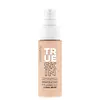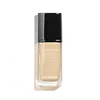Catrice True Skin Hydrating Foundation Versus Chanel Vitalumière Radiant Moisture-Rich Fluid Foundation
What's inside
What's inside
 Key Ingredients
Key Ingredients

 Benefits
Benefits

 Concerns
Concerns

 Ingredients Side-by-side
Ingredients Side-by-side

Water
Skin ConditioningIsododecane
EmollientTalc
AbrasiveCoco-Caprylate
EmollientHydrogenated Tetradecenyl/Methylpentadecene
SolventTrimethylsiloxysilicate
EmollientCetyl PEG/PPG-10/1 Dimethicone
EmulsifyingPropanediol
SolventDimethicone
EmollientSodium Chloride
MaskingPEG-10 Dimethicone
Skin ConditioningSodium Hyaluronate
HumectantCitrullus Lanatus Seed Oil
EmollientTocopherol
AntioxidantDisteardimonium Hectorite
StabilisingCaprylyl Glycol
EmollientTriethoxycaprylylsilane
Dimethiconol Stearate
EmollientHexylene Glycol
EmulsifyingAluminum Hydroxide
EmollientPotassium Sorbate
PreservativeSodium Dehydroacetate
PreservativePhenoxyethanol
PreservativeParfum
MaskingCI 77491
Cosmetic ColorantCI 77492
Cosmetic ColorantCI 77499
Cosmetic ColorantCI 77891
Cosmetic ColorantWater, Isododecane, Talc, Coco-Caprylate, Hydrogenated Tetradecenyl/Methylpentadecene, Trimethylsiloxysilicate, Cetyl PEG/PPG-10/1 Dimethicone, Propanediol, Dimethicone, Sodium Chloride, PEG-10 Dimethicone, Sodium Hyaluronate, Citrullus Lanatus Seed Oil, Tocopherol, Disteardimonium Hectorite, Caprylyl Glycol, Triethoxycaprylylsilane, Dimethiconol Stearate, Hexylene Glycol, Aluminum Hydroxide, Potassium Sorbate, Sodium Dehydroacetate, Phenoxyethanol, Parfum, CI 77491, CI 77492, CI 77499, CI 77891
Water
Skin ConditioningCaprylic/Capric Triglyceride
MaskingGlycerin
HumectantEthylhexyl Palmitate
EmollientRicinus Communis Seed Oil
MaskingUndecane
EmollientPolyglyceryl-3 PCA
EmollientPolyglyceryl-6 Polyhydroxystearate
EmulsifyingSynthetic Fluorphlogopite
Propylene Glycol
HumectantSilica
AbrasivePolyglyceryl-6 Polyricinoleate
EmulsifyingTridecane
PerfumingMagnesium Sulfate
Sodium Chloride
MaskingTerminalia Ferdinandiana Fruit Extract
AntioxidantGlycyrrhiza Glabra Root Extract
BleachingButylene Glycol
HumectantStearalkonium Hectorite
Gel FormingTocopheryl Acetate
AntioxidantParfum
MaskingPotassium Sorbate
PreservativeDisodium Stearoyl Glutamate
CleansingCaprylyl Glycol
EmollientPropylene Carbonate
SolventPentylene Glycol
Skin ConditioningLauroyl Lysine
Skin ConditioningSodium Hyaluronate
HumectantAluminum Hydroxide
EmollientLaminaria Digitata Extract
Skin ProtectingTocopherol
AntioxidantAscorbyl Palmitate
AntioxidantHelianthus Annuus Seed Oil
EmollientCI 77007
Cosmetic ColorantCI 77491
Cosmetic ColorantCI 77492
Cosmetic ColorantCI 77499
Cosmetic ColorantCI 77891
Cosmetic ColorantMica
Cosmetic ColorantWater, Caprylic/Capric Triglyceride, Glycerin, Ethylhexyl Palmitate, Ricinus Communis Seed Oil, Undecane, Polyglyceryl-3 PCA, Polyglyceryl-6 Polyhydroxystearate, Synthetic Fluorphlogopite, Propylene Glycol, Silica, Polyglyceryl-6 Polyricinoleate, Tridecane, Magnesium Sulfate, Sodium Chloride, Terminalia Ferdinandiana Fruit Extract, Glycyrrhiza Glabra Root Extract, Butylene Glycol, Stearalkonium Hectorite, Tocopheryl Acetate, Parfum, Potassium Sorbate, Disodium Stearoyl Glutamate, Caprylyl Glycol, Propylene Carbonate, Pentylene Glycol, Lauroyl Lysine, Sodium Hyaluronate, Aluminum Hydroxide, Laminaria Digitata Extract, Tocopherol, Ascorbyl Palmitate, Helianthus Annuus Seed Oil, CI 77007, CI 77491, CI 77492, CI 77499, CI 77891, Mica
Ingredients Explained
These ingredients are found in both products.
Ingredients higher up in an ingredient list are typically present in a larger amount.
Aluminum Hydroxide is a form of aluminum. It can be naturally found in nature as the mineral gibbsite. In cosmetics, Aluminum Hydroxide is used as a colorant, pH adjuster, and absorbent.
As a colorant, Aluminum Hydroxide may add opacity, or reduce the transparency. Aluminum hydroxide is contains both basic and acidic properties.
According to manufacturers, this ingredient is an emollient and humectant. This means it helps hydrate the skin.
In medicine, this ingredient is used to help relieve heartburn and help heal ulcers.
There is currently no credible scientific evidence linking aluminum hydroxide in cosmetics to increased cancer risk.
Major health organizations allow the use of aluminum hydroxide in personal care products and have not flagged it as a carcinogenic risk at typical usage levels.
Learn more about Aluminum HydroxideCaprylyl Glycol is a humectant and emollient, meaning it attracts and preserves moisture.
It is a common ingredient in many products, especially those designed to hydrate skin. The primary benefits are retaining moisture, skin softening, and promoting a healthy skin barrier.
Though Caprylyl Glycol is an alcohol derived from fatty acids, it is not the kind that can dry out skin.
This ingredient is also used as a preservative to extend the life of products. It has slight antimicrobial properties.
Learn more about Caprylyl GlycolCi 77491 is also hydrated iron III oxide. It's sole purpose is to give a red/pink hue to products.
Iron III oxides are classified as inorganic chemicals for coloring.
Synthetically created Ci 77491 is considered safer than those naturally found. This is because the synthetically created version may contain less impurities. Iron oxides are generally non-toxic and non-allergenic.
Learn more about CI 77491Ci 77492 is also hydrated iron III oxide. It's sole purpose is to give a yellow hue to products.
Iron III oxides are classified as inorganic chemicals for coloring.
Synthetically created Ci 77492 is considered safer than those naturally found. This is because the synthetically created version may contain less impurities. Iron oxides are generally non-toxic and non-allergenic.
Learn more about CI 77492Ci 77499 is also hydrated iron III oxide. It is created from mixing red and black iron oxides. This helps give shades of darkness to a product.
Iron III oxides are classified as inorganic chemicals for coloring.
Ci 77891 is a white pigment from Titanium dioxide. It is naturally found in minerals such as rutile and ilmenite.
It's main function is to add a white color to cosmetics. It can also be mixed with other colors to create different shades.
Ci 77891 is commonly found in sunscreens due to its ability to block UV rays.
Learn more about CI 77891Parfum is a catch-all term for an ingredient or more that is used to give a scent to products.
Also called "fragrance", this ingredient can be a blend of hundreds of chemicals or plant oils. This means every product with "fragrance" or "parfum" in the ingredients list is a different mixture.
For instance, Habanolide is a proprietary trade name for a specific aroma chemical. When used as a fragrance ingredient in cosmetics, most aroma chemicals fall under the broad labeling category of “FRAGRANCE” or “PARFUM” according to EU and US regulations.
The term 'parfum' or 'fragrance' is not regulated in many countries. In many cases, it is up to the brand to define this term.
For instance, many brands choose to label themselves as "fragrance-free" because they are not using synthetic fragrances. However, their products may still contain ingredients such as essential oils that are considered a fragrance by INCI standards.
One example is Calendula flower extract. Calendula is an essential oil that still imparts a scent or 'fragrance'.
Depending on the blend, the ingredients in the mixture can cause allergies and sensitivities on the skin. Some ingredients that are known EU allergens include linalool and citronellol.
Parfum can also be used to mask or cover an unpleasant scent.
The bottom line is: not all fragrances/parfum/ingredients are created equally. If you are worried about fragrances, we recommend taking a closer look at an ingredient. And of course, we always recommend speaking with a professional.
Learn more about ParfumPotassium Sorbate is a preservative used to prevent yeast and mold in products. It is commonly found in both cosmetic and food products.
This ingredient comes from potassium salt derived from sorbic acid. Sorbic acid is a natural antibiotic and effective against fungus.
Both potassium sorbate and sorbic acid can be found in baked goods, cheeses, dried meats, dried fruit, ice cream, pickles, wine, yogurt, and more.
You'll often find this ingredient used with other preservatives.
Learn more about Potassium SorbateChances are, you eat sodium chloride every day. Sodium Chloride is also known as table salt.
This ingredient has many purposes in skincare: thickener, emulsifier, and exfoliator.
You'll most likely find this ingredient in cleansers where it is used to create a gel-like texture. As an emulsifier, it also prevents ingredients from separating.
There is much debate on whether this ingredient is comedogenic. The short answer - comedogenic ratings don't tell the whole story. Learn more about comegodenic ratings here.
The concensus about this ingredient causing acne seems to be divided. Research is needed to understand if this ingredient does cause acne.
Scrubs may use salt as the primary exfoliating ingredient.
Learn more about Sodium ChlorideSodium Hyaluronate is hyaluronic acid's salt form. It is commonly derived from the sodium salt of hyaluronic acid.
Like hyaluronic acid, it is great at holding water and acts as a humectant. This makes it a great skin hydrating ingredient.
Sodium Hyaluronate is naturally occurring in our bodies and is mostly found in eye fluid and joints.
These are some other common types of Hyaluronic Acid:
Learn more about Sodium HyaluronateTocopherol (also known as Vitamin E) is a common antioxidant used to help protect the skin from free-radicals and strengthen the skin barrier. It's also fat soluble - this means our skin is great at absorbing it.
Vitamin E also helps keep your natural skin lipids healthy. Your lipid skin barrier naturally consists of lipids, ceramides, and fatty acids. Vitamin E offers extra protection for your skin’s lipid barrier, keeping your skin healthy and nourished.
Another benefit is a bit of UV protection. Vitamin E helps reduce the damage caused by UVB rays. (It should not replace your sunscreen). Combining it with Vitamin C can decrease sunburned cells and hyperpigmentation after UV exposure.
You might have noticed Vitamin E + C often paired together. This is because it is great at stabilizing Vitamin C. Using the two together helps increase the effectiveness of both ingredients.
There are often claims that Vitamin E can reduce/prevent scarring, but these claims haven't been confirmed by scientific research.
Learn more about TocopherolWater. It's the most common cosmetic ingredient of all. You'll usually see it at the top of ingredient lists, meaning that it makes up the largest part of the product.
So why is it so popular? Water most often acts as a solvent - this means that it helps dissolve other ingredients into the formulation.
You'll also recognize water as that liquid we all need to stay alive. If you see this, drink a glass of water. Stay hydrated!
Learn more about Water